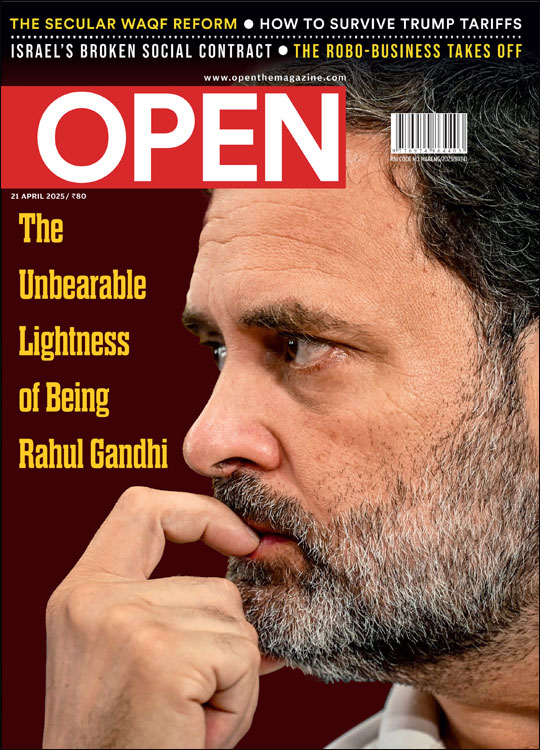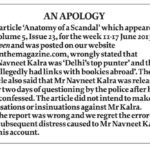The Rebel
She was born into privilege and could easily have chosen the easy life. But Anuradha Ghandy chose guns over roses to fight for the dispossessed.
 Rahul Pandita
Rahul Pandita
 Rahul Pandita
Rahul Pandita
 |
23 Sep, 2009
|
23 Sep, 2009
/wp-content/uploads/2015/11/the-rebel-1.jpg)
She was born into privilege and could easily have chosen the easy life. But Anuradha Ghandy chose guns over roses to fight for the dispossessed.
On a muggy April evening in 2008, somewhere in Mumbai, a doctor was trying desperately to get in touch with his patient. The patient happened to be a woman in her early 50s, who had come that morning with high fever. The doctor had advised a few blood tests, and, as he saw the reports, he started making frantic calls to the phone number the patient had scribbled in her nearly illegible handwriting. The number, he soon realised, did not exist. He was restless. The reports indicated the presence of two deadly strains of malaria in the woman’s bloodstream—she had to be admitted to a hospital without delay. Time was racing by and there was no trace of her.
By the time the woman contacted the doctor again, a few days had passed. The doctor wanted her placed under intensive care immediately. But it was too late.
The next morning, on April 12, Anuradha Ghandy was dead. She had suffered multiple organ failure, her immune system already weakened by systemic sclerosis, an auto-immune disease responsible for, among other things, her bad handwriting.
The news spread quickly among friends and followers of Anu, as she was fondly called. Before long news had reached Indora, a Dalit basti in Nagpur where Anu had lived for seven years. This was before her name appeared in the Home Ministry dossiers as Janaki alias Narmada alias Varsha – the only woman in the CPI(Maoist)’s Central Committee, the highest decision-making body of the Naxalites.
How did the daughter of a high profile lawyer of Bombay High Court, a graduate of the city’s prestigious Elphinstone college, an M.Phil in Sociology, a girl born into privilege, come to choose a life of struggle and hardship in the treacherous jungles of Bastar, a rifle by her side and a tarpaulin sheet for a bedding? The answer perhaps lies in the times she lived in. Or the kind of person she was. Or maybe a bit of both.
Anuradha was born to Ganesh and Kumud Shanbag, both of them activists, who chose to marry in the office of the Communist Party of India (CPI). As a young boy, Ganesh Shanbag had run away from his home in Coorg to join Subhash Chandra Bose’s army, and later, as a lawyer, he would fight the cases of communists arrested in the Telangana struggle. While his briefcase would be full of petitions filed on behalf of the arrested comrades, Kumud would be busy knitting and collecting sweaters to be sent for soldiers fighting war with China.
Anuradha’s brother Sunil Shanbag, who is a progressive playwright, recalls her being good at studies as well as extra-curricular activities like dancing. But she was extremely aware of what was happening around her. Says Sunil: “When I was in boarding school, she would send me letters, writing about issues like the nationalisation of banks. And she was only 12 then.” But beyond this awareness, Anuradha was like any other girl when she joined college in 1972. “She would come home and straighten her hair with the help of a warm iron as girls would do in those days,” recalls Kumud Shanbag.
The early 70s were heady days for the youth. Much was happening all around the world. Mao had ushered in the Cultural Revolution in China. Vietnam was offering fierce resistance to the American forces. Back home, the spring thunder of Naxalbari had erupted. Hundreds of students of elite colleges were giving up their careers and joining the Naxalite movement. Young men from affluent families, who had gone abroad for higher studies, were getting radicalised. One of them was an alumnus of Doon School, and a classmate of Sanjay Gandhi. Kobad Ghandy’s father was a top Glaxo executive, and the family lived in a sprawling sea-facing flat in Worli. He had gone to pursue a course in chartered accountancy in England, and it was there that he got initiated in radical politics. Leaving his course unfinished, he returned.
Meanwhile, Anuradha had been working as a lecturer, but she was dedicated to the Progressive Youth Movement (PROYOM), which drew its inspiration from the Naxal movement. Later, she would become one of the torchbearers of the civil liberties movement in Mumbai. It is around this time that Anuradha and Kobad came in touch with each other. It is not clear who inspired whom, but soon both had turned “staunch activists,” as one common friends puts it.
The two soon fell in love, and Kumud vividly remembers the day Kobad came visiting their house. “My husband was here on this chair,” she points out, “and Kobad came and fell on his knees and said: ‘Can I marry your daughter?’”
The two got married in November 1977.
By 1980, Naxal squads from the erstwhile CPI(ML) (People’s War) were entering Dandakaranya—a swathe of forest spread across Andhra Pradesh, Chhattisgarh, Maharashtra, and Orissa—to set up a guerrilla base. In 1981, the founder of the People’s War, Kondapalli Seetharamaiah expressed his desire to meet Kobad during a conference of the Radical Students’ Union in Andhra Pradesh. The People’s War was keen to enter the Gadchiroli region of Maharshtra. Naxal ideologue Varvara Rao says the meeting between the two paved the way to the formation of People’s War in Maharashtra.
The couple’s commitment was total. A year later, Anuradha moved to Nagpur, which has the second largest slum population in Maharashtra, and is also home to a significant number of Dalits (It was in Nagpur in October 1956 that BR Ambedkar accepted Buddhism). She first stayed in a barsati [small, one-room terrace apartment] in the Lakshmi Nagar area. Kumud remembers visiting her there with her husband. “When we saw where she stayed, we couldn’t believe our eyes,” says Kumud. The roof leaked from many places. And it rained that night. “Our helper was with us who crept under a table and slept there,” recalls Kumud.
By 1986, however, Anuradha had shifted to north Nagpur’s Indora locality, the epicentre of Dalit politics. She rented two small rooms at the house of a postal department employee, Khushaal Chinchikhede. “There was absolutely nothing in their house except two trunksful of books and a mud pitcher,” he says. Anuradha also worked as part-time lecturer in Nagpur University. Later, Kobad would also come to live there. Both would be out till midnight. Anuradha used a rundown cycle to commute, and it was later at the insistence of other activists that Kobad bought a TVS Champ moped.
Indora was notorious for its rowdies. “No taxi or autorickshaw driver would dare venture inside Indora,” says Anil Borkar, who grew up in Indora. But Anuradha was unfazed. “She would pass though the basti at midnight, all alone on a cycle,” remembers Borkar. He met Anuradha through a friend. “She made me aware of so many things. It was like the whole world opened in front of me,” he says.
Because of Anuradha, Devanand Pantavne, a black belt in karate turned into a poet and the lead singer of a radical cultural troupe. Pantavne remembers her as a stickler for deadlines. “She would get very angry if we took up a job and then didn’t deliver on time,” he says. Another young man, Surendra Gadling was motivated by Anuradha to take up law. Today, he fights cases for various activists and alleged Naxals. “She is my guiding light,” he says. It is not without reason. Anuradha led by example, living the life she wanted the basti boys to lead.
In 1994, a Dalit woman, Manorama Kamble, working as a maid in an influential lawyer’s house was found dead, with the lawyer’s family claiming that she had accidently electrocuted herself to death. But the activists feared that she had been raped and then killed by the lawyer. Anuradha led an agitation, and it was due to her efforts that the case created ripples in the state assembly and in Parliament.
In Indora, one of Anuradha’s trusted lieutenants was Biwaji Badke, a 4ft-tall Dalit activist. “Every morning Badke would come to her house and share all news with Anuradha over tea,” recall friends. Later, when he was diagnosed with throat cancer, Anuradha brought him to her house and nursed him for months. Another associate, Shoma Sen remembers her being very sensitive to the lives of others. “Her house in Indora was open to everyone. Every time someone would come and one more cup of water would be added to the tea,” she says.
Because of her, many others from well-to-do families were inspired to become activists. Says her old friend and associate of her activist days, Susan Abraham: “When I became an activist it was always heartening to see someone from Anu’s background working along with you.”
It was in the mid 90s that Anuradha joined the Naxal leadership in the jungles of Bastar and finally went underground. Maina, a member of the CPI-Maoist’s Special Zone Committee in Dandakaranya, remembers her efforts to mingle with the local Gond tribals: “Many people used to question us about her, saying didi (Anuradha) is not from this country, she does not know our language. Didi would smilingly approach them saying: ‘I know what you are asking; please teach me your language; I will learn everything from you.’”
Life in the jungle is very harsh. The guerrillas are always on the move, from one village to another, carrying heavy kitbags. Even there, Anuradha wouldn’t shy away from enduring hardships; she did everything that other guerrillas would do. A Naxal leader, who was in Bastar when she first came there, remembers her not sparing herself any of the regular military drill: running, crawling, push-ups, the works. Says Maina, “She would slip and fall many times while walking in the slushy mud, but she would get up and laugh.”
In 1999, Anuradha was camping along with other guerillas in Chhattisgarh’s Sarkengudem village when the police surrounded them. An encounter ensued. Lahar, a senior guerilla remembers Anuradha taking cover and aiming her gun at the ‘enemy’. Later, she would always recollect that incident, urging the youth to learn the skills of guerrilla warfare. But Sunil remembers her speaking about the “awkwardness of carrying a gun.”
The hard life of the jungle was not easy on her body—she suffered frequent bouts of malaria. During the same summer, she had been walking for hours one day when she stopped and lost consciousness. Her comrades made her drink glucose water. Apparently, she had suffered a sun-stroke. After she recovered, she refused to hand over her kit-bag to others, says Lahar.
When south Bastar was affected by severe drought in 1998-99, the tribals were forced to eat rice, which, Maina says, “had more stones than grain in it.” The same rice was offered to the guerrillas as well, which they would eat with tamarind paste. “Taking one fistful after another and then gulping water in between, she used to take a lot of time to finish her meal,” recalls Maina. She also developed ulcers in her stomach. “She would relieve the pain by eating one or two biscuits and a glass of water,” she says.
To lessen her load, Anuradha also decided to do away with the heavy blanket guerrillas carry, opting instead for a thin bedsheet. It was during this time that she developed sclerosis.
No matter what the Centre claims, the Naxals often fill in the void created by the government in their areas of influence. In Basaguda in Chhattisgarh, an embankment needed to be built around a tank called Kota Chervu; some ten villages were counting on supplies from this tank. The government had ignored the villagers’ pleas for years. It was under Anuradha’s guidance that people from 30 villages undertook this work. Those who worked were given a kilogram of rice a day. The government panicked and sanctioned Rs 20 lakh; it was refused. By 1998, more than a hundred tanks had been constructed by the Naxals in Dandakaranya.
Anuradha also took on the responsibility of crafting learning models to educate women. She regularly took classes on the problems faced by women guerillas, and wrote and translated Naxal propaganda material. She would prepare charts with photos of political leaders and explain world affairs to local illiterates. Sometimes, she would conduct classes on health issues.
Between all this, Anuradha would make secret trips to Mumbai. “She would come, and I would apply oil in her hair and massage her body. I wanted to pamper her as much as I could,” says Kumud.
“The most amazing thing was she would always know much more than us about films and other popular culture,” says Sunil. During the staging of one of his plays in Mumbai, Anuradha slipped in quietly, watched the play, and left quietly. “I came to know later that she was there,” says Sunil.
At the ninth congress of the CPI(Maoist) in 2007, Anuradha was made a member of the central committee. By this time, Kobad had become one of the key Naxal leaders, in charge of party documentation. (He was arrested in Delhi on September 20).
It was on the basis of Anuradha’s work that the Naxals prepared the first-ever caste policy paper within the Marxist movement in India. She also drafted papers on ‘Marxism and Feminism’, of which the top Naxal leadership took note.
During the time spent in Dandakaranya, Anuradha helped the guerrillas overcome the limitations of collective work by making them understand what roles cooperatives could play in increasing agricultural production.
In Bastar, Anuradha raised questions on the patriarchal ideas prevalent in the party. At the time of her death, she had been working with the woman cadre, to devise plans that would help them take greater leadership responsibilities. It was in Jharkhand while taking classes with the tribals on the question of women’s oppression that she contracted cerebral malaria, which led to her death.
In her memoirs of Anuradha, her friend Jyoti Punwani wrote: “The ‘Naxalite menace’, says Manmohan Singh, is the biggest threat to the country. But I remember a girl who was always laughing and who gave up a life rich in every way to change the lives of others.”
In Nagpur, I requested Chinchikhede to open the rooms once occupied by Anuradha. All that remained of the old days was a sticker of Bhagat Singh on the door. It was sunset and the sky had turned crimson. A comrade who accompanied me lay on the floor, a floor he was too familiar with. And he recited a poem by Gorakh Pandey:
It’s thousands of years old/their anger/thousands of years old/is their bitterness/I am only returning their scattered words/with rhyme and rhythm/ and you fear that/ I am spreading fire.
About The Author
CURRENT ISSUE
The Unbearable Lightness of Being Rahul Gandhi
MOst Popular
3

/wp-content/uploads/2025/04/Cover-Congress.jpg)











More Columns
Ukraine silently encroaches on ‘friendly’ Moldova Ullekh NP
NFRA chief Ajay Pandey joins AIIB Rajeev Deshpande
The Revenge of Roughage V Shoba